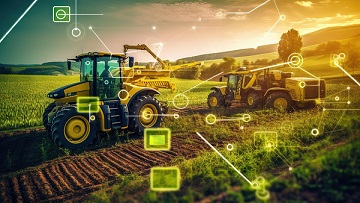
Source freepik
Now is the time of unprecedented proliferation of technology in agriculture. Formerly a tech novelty, the Internet of Things (IoT) is becoming mainstream among agribusinesses alongside satellites, drones, and self-steering machinery due to lower barriers to adoption and proven efficiency in tackling farming challenges. The Internet of Things can be explained as a network of devices connected to the cloud and each other via a cellular or satellite network. IoT devices are equipped with advanced sensors that collect and share data and, owing to high-bandwidth telecommunication, let users access such data in real-time to make informed decisions.
IoT and smart farming
IoT is at the forefront of smart farming, which integrates current sensing, data computing, and communications technologies into agricultural practices to increase productivity and decrease production costs. IoT utilizes sensors, drones, robots, and farming software that meets daily needs of growers for field monitoring, efficient use of resources, input optimization, disease and pest control, and more.
The IoT sensors installed in fields, irrigation systems, and cultivating equipment collect a wealth of data about crop health, soil moisture, assets, and local climate conditions. Not only do farmers get a crystal clear picture of what is happening on their farms but they can also make calculations and predictions based on crop monitoring data to optimize their cultivating strategies and get more output with less input. Automation at the core of the IoT concept ensures all components within the network of digitally connected devices work smoothly without human involvement. As a result, farm labor costs decrease without compromising productivity.
When combined with artificial intelligence (AI), IoT empowers the devices to learn, predict and make decisions on their own. For example, IoT is widely used in irrigation: sensors in fields, water tanks, and silos keep growers updated on the amount of used and remaining water, making irrigation more efficient. Adding AI to this system makes irrigation even smarter: the neural networks can process multiple variables (soil moisture, evaporation, plant water usage, and weather data) and optimize watering schedules. Such smart irrigation increases the efficiency of watering while reducing water consumption and waste, as well as decreasing irrigation costs.
Remote sensing in agriculture
The Internet of Things in agriculture utilizes a variety of sensors collecting information about crops and their environment right from within the field. However, there are other valuable data sources that can only enhance the benefits of applying this technology in farming.
Remote sensing works the other way around collecting information about crops, soils, and weather at a distance: from above the field (drones) or from space (satellites). Such sensors record the electromagnetic energy reflected by vegetation, water bodies, urban structures, etc. producing digital images of the Earth’s surface that reveal what the human eye cannot see. Remote sensing analysis enables large-scale satellite crop monitoring throughout the season and AI-powered classification and prediction applications, such as mapping crop varieties, soil moisture estimation, and yield prediction that can dramatically improve field management. High-resolution satellite imagery can become the “eyes” for smart IoT devices, telling agricultural drones where to spray more or less fertilizer or coordinating seed-sowing robots for precise planting.
Agricultural applications of remote sensing
A healthy plant and a stressed plant reflect the electromagnetic energy differently. In terms of science, we would say they have different spectral reflectance, which is unique to every plant or object observed. Over the years, this ability of remote sensing technology has proved its use in multiple aspects of agriculture.
- Crop observation. Multispectral satellite imagery is widely used in monitoring plant health across large croplands. For instance, an infrared band of the electromagnetic spectrum is sensitive to crop vigor, damage, and stress. Therefore, the corresponding spectral measurements taken by a satellite sensor can help detect stressed plants and take timely action. In recent years, a lot of digital crop monitoring systems have emerged to simplify the use of the technology by unaware farmers. EOS Data Analytics (eos.com) developed a digital platform EOSDA Crop Monitoring which provides satellite data alongside analytical tools to derive actionable crop insights. It helps detect plants affected by heat, cold or water stress, pest and weeds, or diseases at an early stage and prevent yield losses.
- Soil monitoring. Soil supplies water and nutrients to plants that are vital for their growth. The analysis of multi- or hyperspectral satellite images can be used to estimate and keep track of various soil properties, including soil moisture, soil salinity, pH, and macronutrient content (nitrogen, potassium, and phosphorus). In EOSDA Crop Monitoring system, users can generate vegetation and productivity maps of their fields to identify nutrient-deficient areas and optimize fertilizer use using the variable rate application technology.
- Weather monitoring. Weather conditions impact crop development and future yields. With the ongoing climate change, crop growers are faced with a serious challenge and are forced to adapt their farm structures and production methods to meet production demands while using resources sustainably. EOSDA Crop Monitoring offers 14-day weather forecasts that help plan all the field activities, including irrigation scheduling: farmers can better predict the crop needs and cut unwanted costs. Historical field-level weather data available on the platform is also key to tracing the correlation between previous yields and weather conditions and making better management decisions.
The role of IoT in farming
IoT technology and its data-driven approach are revolutionizing all agricultural production processes, making them more advanced and efficient. Agribusinesses utilizing smart IoT solutions increase their revenue through improved farming strategies. They are able to mitigate climate change effects more effectively and manage their fields more sustainably with precise crop monitoring, weather and soil data, benefiting the optimized input and water use. Considering the predicted increase in global food demand and resource deficiency, the Internet of Things is seen as a solution for producing agricultural products of better quality, larger quantity, and with more profit.
According to a recent study from Purdue University, an average net benefit from adopting precision agriculture, including IoT, totals around 90$ per acre. And the benefits are twofold: producers improve control and efficiency of their farming operations and considerably cut their costs, while consumers get safer and more eco-friendly food due to reduced chemicals use and subsequent environmental impact.

